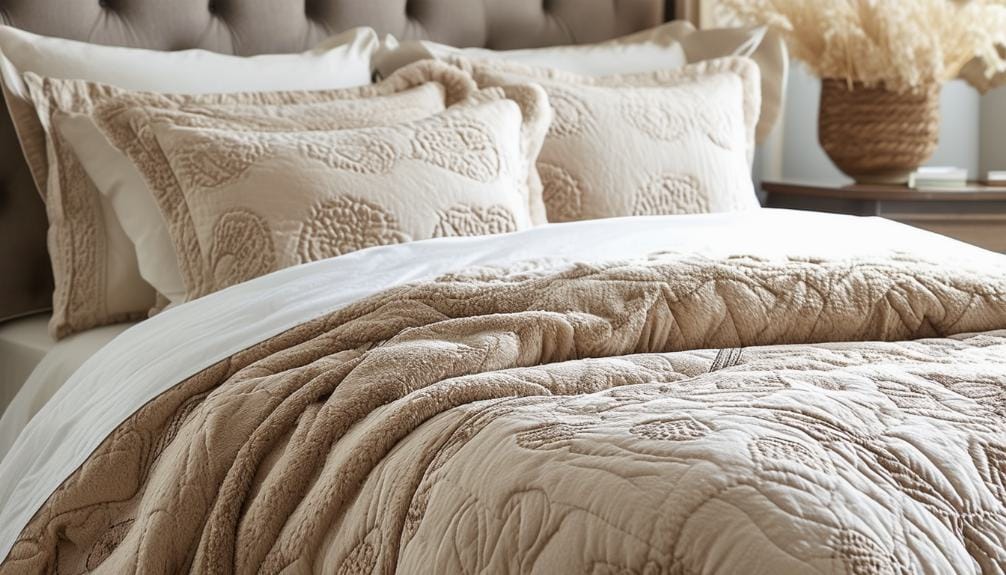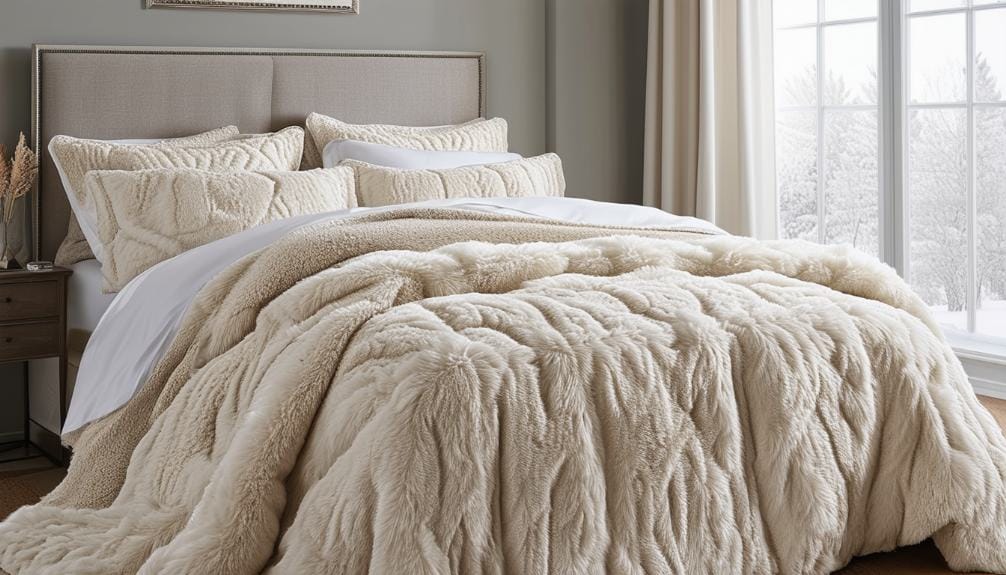Does A Coverlet Go Over A Comforter? What You Need To Know
Unsure how to layer your bedding for ideal comfort and style? You’re not alone. Deciding whether a coverlet should go over a comforter can be tricky, but comprehending their distinct roles is key. Coverlets are often used to add a decorative touch while providing an extra layer of warmth – but do they really belong on top? Discover how these versatile bedding pieces work together to transform your bedroom into a cozy retreat. From seasonal adjustments to personal preferences, the right coverlet can make all the difference. Keep reading to uncover the secrets to crafting the perfect, layered bed.
Defining a Coverlet
A coverlet is a lightweight, decorative bed covering designed to sit on top of a comforter or duvet. It provides extra warmth, texture, and visual interest to your bed.
Unlike a comforter, a coverlet lacks internal filling, consisting of a single fabric layer. Coverlets are often crafted from materials like cotton, linen, or jacquard, lending them a unique and appealing texture.
Various weaving techniques create coverlets, ranging from intricate jacquard patterns to simpler, solid designs. This range in materials and weaving methods means coverlets are available in numerous colors and patterns, making them a versatile addition to your bedroom decor.
Whether you want to introduce a pop of color, add a touch of elegance, or simply include a cozy layer to your bedding, a coverlet is a practical choice that can elevate the look and feel of your sleeping space.
Coverlet Vs. Comforter
Coverlets and comforters each have their own roles in creating a cozy and stylish bedroom. A coverlet, which is a single layer of fabric, is perfect for adding decorative flair with its intricate patterns and lightweight design. It complements your bedroom decor without adding too much warmth.
On the other hand, a comforter, with its stitched-in fill, is essential for providing the warmth and insulation needed for a restful sleep.
Think about the seasons to get the most out of your bedding. In warmer months, a lightweight coverlet can give your bed a polished look without making you too hot. During colder months, layering a coverlet over your comforter can add an extra layer of warmth and coziness. This way, you can adjust your bedding to match your comfort needs throughout the year.
- Coverlets add decorative patterns and a light, extra layer.
- Comforters deliver the main warmth and insulation for sleeping.
- Using both a coverlet and comforter lets you adapt your bedding to seasonal changes.
Layering Bedding Options

Layering a coverlet over your comforter adds both style and functionality to your bedding. This extra layer not only boosts the warmth and coziness of your bed but also brings texture and depth to your bedroom decor. The lighter, decorative coverlet pairs well with the heavier comforter, allowing you to mix and match fabrics and patterns.
This technique is versatile and works with various design styles, from traditional to modern. A coverlet’s breathability makes it a practical choice for warmer weather, providing an adjustable layer that you can easily add or remove.
Play around with different colors and textures to create a look that fits your personal style. Whether you’re aiming to add visual interest or improve the functionality of your bedding, layering a coverlet over a comforter is a simple and effective way to elevate the overall aesthetic and comfort of your sleeping space.
Advantages of Using a Coverlet
A coverlet offers a practical way to add warmth and texture to your bed without the bulk of a comforter. They come in a wide range of materials and designs, making it easy to match your bedroom decor. From cozy woven fabrics to luxurious satin, the options are extensive, allowing you to find something that fits your personal style.
Coverlets also provide numerous design choices. Whether you prefer elegant patterns, vibrant colors, or simple solid hues, there’s something to complement your existing bedding. Layering a coverlet over your comforter can create a more polished, sophisticated look, enhancing the overall appearance of your bedroom.
One major benefit is that coverlets are easier to wash and care for compared to bulky comforters. This makes them a convenient option for frequent laundering. Additionally, switching out a coverlet is an affordable way to refresh your bedroom’s look without replacing the entire bedding set.
Choosing the Right Coverlet

Choosing the right coverlet involves considering your bed size and comforter to ensure a good fit. Pick a coverlet that’s big enough to hang evenly over the sides of your mattress for a neat and polished look.
Color coordination is also crucial. Select a shade that complements your comforter and other bedding pieces to create a cohesive appearance. Solid colors or subtle patterns often work best for a sophisticated and unified look.
The fabric of your coverlet is another important factor. Opt for breathable materials like cotton or linen, which won’t trap heat like heavier fabrics. This helps your comforter maintain its temperature-regulating properties. Plus, these lightweight fabrics drape nicely over your bedding ensemble.
Styling a Coverlet-Covered Bed
Styling a bed with a coverlet can elevate its appearance and functionality.
- Fold the coverlet at the foot of the bed for a relaxed, layered look. This method is handy for adjusting to different temperatures easily.
- Tuck the coverlet in at the sides to give your bed a neat, tailored appearance. This technique works well with the plush, puffy texture of a comforter.
- For a softer, more streamlined look, drape the coverlet over the top of the comforter to create a smooth, seamless surface.
- Mix and match textures and patterns between your coverlet and comforter to add visual depth and personality to your bedding setup.
- Experiment with different placements to find the style that best suits your personal taste and the overall aesthetic of your bedroom.
Frequently Asked Questions
Can I Use a Coverlet in Place of a Comforter?
You can use a coverlet in place of a comforter, but it may not provide the same level of warmth and coverage. Coverlets are generally lighter and designed to be used as an accent piece rather than a primary bedding layer.
How Much Warmer Is a Coverlet Compared to a Comforter?
A coverlet’s insulating properties are quite modest compared to a comforter’s thermal performance. While a coverlet adds a lightweight layer of warmth, it won’t provide the same level of coziness and heat retention as the thicker, more insulating comforter.
Should I Choose a Coverlet in the Same Color as My Comforter?
Choosing a coverlet in the same color as your comforter can create a cohesive, coordinated look. However, selecting complementing patterns or colors can add visual interest and better coordinate with your overall decor.
Can I Machine Wash a Coverlet?
You can machine wash a coverlet, but be sure to follow the care instructions from the manufacturer. Consider the size of your machine and the fabric to guarantee you don’t damage the coverlet.
Is a Coverlet Necessary for a Guest Bedroom?
While a coverlet isn’t essential, it can provide a cozy touch and update the guest room’s look. Consider versatile coverlet fabric options and place it thoughtfully for an inviting, visually appealing space your guests will appreciate.
Conclusion
Yes, a coverlet does go over a comforter.
Layering a coverlet on top of a comforter allows you to easily adjust the warmth and add visual interest to your bedding. The breathable nature of a coverlet makes it suitable for warmer weather, while the comforter provides the primary insulation.
This versatile bedding combination enables you to adapt your bed to seasonal changes and personal preferences.
